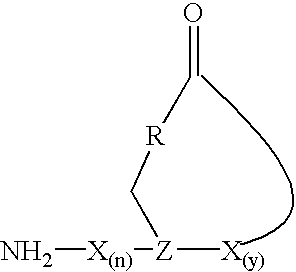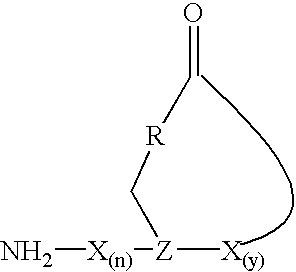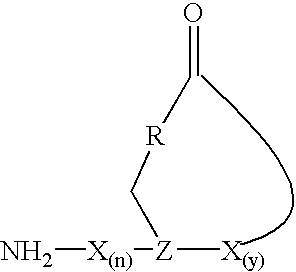Staphylococcus peptides for bacterial interference
a technology of bacterial interference and peptides, which is applied in the direction of peptides/protein ingredients, peptides, immunoglobulins, etc., can solve the problem that little is known about the biochemistry of the agrd/agrc interaction
- Summary
- Abstract
- Description
- Claims
- Application Information
AI Technical Summary
Benefits of technology
Problems solved by technology
Method used
Image
Examples
example 1
Synthesis of a Novel Class of Peptides Responsible for S. aureus Bacterial Interference
[0043]The initial synthetic route to the AgrD thiololactone peptides, involving the solution-based cyclization of a thiol ester precursor, proved problematic due to the difficulties associated with the synthesis of the linear starting material. A more efficient strategy was thus developed which involved solid-phase cyclization as the final synthetic step (FIG. 1A). Key to this process was the ability to prepare a fully unprotected peptide immobilized on a solid-suppport through a reactive thiol ester bond. This was achieved using the recently described 3-mercaptopropionamide-polyethylene glycol-poly-(N,N-dimethylacrylamide) [HS-PEGA] support (Camarero, J. A., 1998) in combination with Boc-solid phase peptide synthesis (SPPS) (Schnolzer, M., et al., 1992). The acid stability of the alkyl-thiol ester linkage between the peptide and the resin means that the completed peptide can be globally deprotect...
example 2
Functional Significance of the Cyclic Ring Structure
[0047]The precision and convenience of the synthetic approach makes it possible to systematically vary the chemical structure of the peptides, thus enabling detailed structure-activity studies to be performed. With respect to the AgrD peptides, the initial focus was on the following questions: (i) Which amino acids within the sequence are most important for affinity / selectivity? (ii) What is the role of the thiololactone unit in activation and inhibition of the agr response? To address the first of these issues, an alanine scan was performed on the group II AgrD peptide. Each of the alanine-modified AgrDII peptide variants was prepared and characterized as before, and in each case the purified peptide assayed for its ability to activate or inhibit the agr response in each of the three S. aureus strains. Analysis of the results summarized in FIG. 2C, reveals that there are certain amino acids, residing both within the ring and the t...
example 3
Lactone and Lactam Variants in the Cyclic Ring Structure Provide Peptides Capable of Inhibitory Activity Without Activation Activity
[0049]Thiol ester groups are moderately good acylating agents, a property which is utilized in several biological processes (Law, S. K. and A. W. Dodds. 1997; Xu, M.-Q., and F. B. Perter, 1996; Porter, J. A., et al., 1996). It is intriguing to speculate that upon receptor binding, the thiololactone present in the AgrD peptides serves as an acyl donor for the covalent modification of a specific residue within AgrC. The effect of replacing the thiololactone unit in AgrDII with both ester (lactone) and amide moieties (lactam) was of interest. In principle, both of these variants should be significantly less reactive than the thioester peptide ( ), while the lactone variant of AgrDII should also be isosteric to wildtype. Synthesis of the desired AgrDII lactone and lactam variants was achieved via solution cyclization of a partially protected intermediate, f...
PUM
| Property | Measurement | Unit |
|---|---|---|
| Structure | aaaaa | aaaaa |
Abstract
Description
Claims
Application Information
 Login to View More
Login to View More - R&D
- Intellectual Property
- Life Sciences
- Materials
- Tech Scout
- Unparalleled Data Quality
- Higher Quality Content
- 60% Fewer Hallucinations
Browse by: Latest US Patents, China's latest patents, Technical Efficacy Thesaurus, Application Domain, Technology Topic, Popular Technical Reports.
© 2025 PatSnap. All rights reserved.Legal|Privacy policy|Modern Slavery Act Transparency Statement|Sitemap|About US| Contact US: help@patsnap.com



